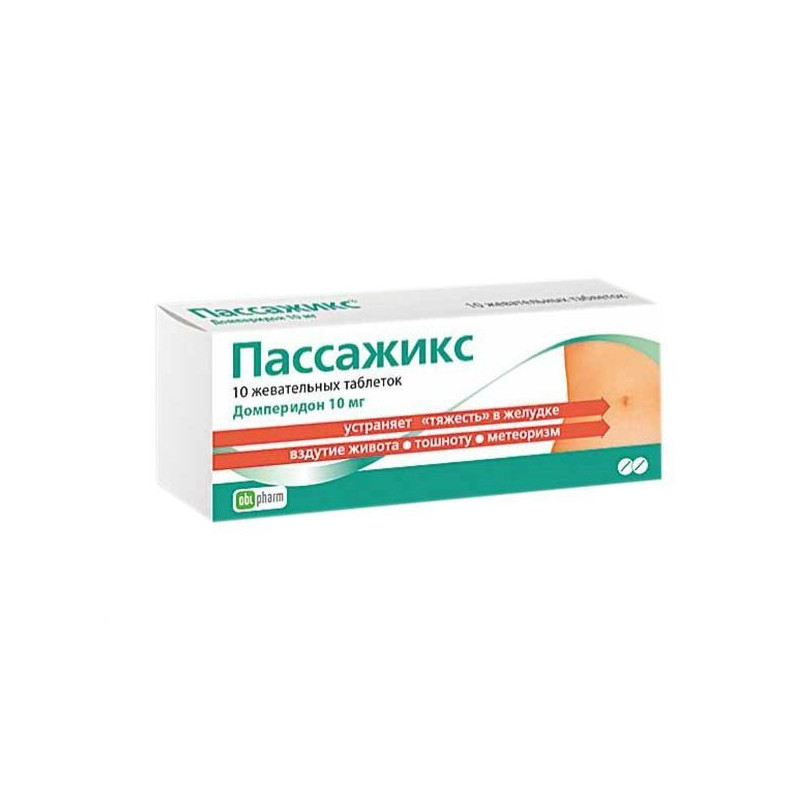



 All payments are encrypted via SSL
All payments are encrypted via SSL
 Full Refund if you haven't received your order
Full Refund if you haven't received your order
Antiemetic, a motility stimulator of the gastrointestinal tract. Domperidone is a dopamine antagonist, which has, like Metoclopramide and some antipsychotics, antiemetic properties. However, unlike these drugs domperidone poorly penetrates through the BBB. Domperidone use is rarely accompanied by extrapyramidal side effects, especially in adults, but domperidone stimulates the secretion of prolactin from the pituitary gland. An antiemetic effect is probably due to a combination of peripheral (gastrokinetic) action and antagonism of dopamine receptors in the trigger zone of chemoreceptors. When ingested, domperidone increases the duration of antral and duodenal contractions, accelerates gastric emptying - the release of liquid and semi-solid fractions in healthy people and solid fractions of ill patients, when,when this process has been slowed down and increases the pressure of the sphincter of the lower esophagus in healthy people. Domperidone has no effect on gastric secretion.
Anticholinergic drugs can neutralize the effect of domperidone. The bioavailability of domperidone when administered orally is reduced after previous intake of cimetidine or sodium bicarbonate. Do not take antacid and antisecretory drugs simultaneously with domperidone, because they reduce its bioavailability (domperidone should be taken before meals, and antacid or antisecretory drugs - after meals). When used with drugs that inhibit the CYP3A4 isoenzyme (antifungal drugs of the azole series, macrolide antibiotics, HIV protease inhibitors, nefazodone), for example with Ketoconazole, it is possible to increase the level of domperidone in the plasma. Domperidone can be combined with neuroleptics, the effect of which it does not enhance; dopaminergic receptor agonists (bromocriptine, levodopa), the undesirable peripheral effects of which, such as digestive disorders, nausea, vomiting, it suppresses without neutralizing their main properties.
Store in a dry, protected from light, out of reach of children, at room temperature no higher than 25 ° C.
A complex of dyspeptic symptoms, often associated with delayed gastric emptying,gastroesophageal reflux, esophagitis: feeling of fullness in the epigastrium, feeling of bloating, pain in the upper abdomen, belching, flatulence, nausea, vomiting, heartburn. Nausea and vomiting of functional, organic, infectious origin, caused by radiotherapy, drug therapy or a violation of the diet. Nausea and vomiting caused by dopamine agonists when used in Parkinson’s disease (such as levodopa and bromocriptine).
Gastrointestinal bleeding, mechanical obstruction or perforation, in which the stimulation of the motor function of the stomach can be dangerous; prolactin-secreting pituitary tumor (prolactinoma); simultaneous administration of oral ketoconazole; hypersensitivity to the drug components. Care should be taken in patients with hepatic insufficiency (given the high degree of metabolism of domperidone in the liver).
On the part of the digestive system: rarely - disorders of the gastrointestinal tract; in isolated cases - transient spasms of the intestine. For the central nervous system: extrapyramidal symptoms (very rarely in children; in isolated cases in adults); completely reversible and disappear after cessation of treatment. From the endocrine system: possible hyperprolactinemia, rarely leading to galactorrhea, gynecomastia, amenorrhea. Allergic reactions: rarely - rash, urticaria.
1. In chronic dyspepsia : children from 5 to 12 years old (it is recommended to prescribe lozenges): 10 mg (1 tablet) 3 times / day for 15-30 minutes before meals and, if necessary, before bedtime. Children aged up to 5 years, the drug in the form of a suspension is prescribed at the rate of 2.5 ml / 10 kg body weight (which corresponds to 250 μg / kg body weight) 3 times / day. The maximum daily dose is 80 mg (2.4 mg / kg body weight), except for children up to years. Adults and children over 12 years: 10 mg (1 tablet) 3 times / day for 15-30 minutes before meals and, if necessary, before bedtime. In the absence of the desired effect, this dorsing can be doubled. 2. In case of nausea and vomiting: children aged 5 to 12 years (it is recommended to appoint lozenges): 10 mg (1 tablet) 3-4 times / day before meals and before bedtime. The maximum daily dose is 2.4 mg / kg of body weight, but not more than 80 mg. Adults and children over 12 years old: at 20 mg (2 tab.) 3-4 times / day before meals and before bedtime. The maximum daily dose is 80 mg.
In case of renal insufficiency, an increase in the interval between administration of the drug is recommended. When re-prescribing, the frequency of administration should be reduced to 1-2 times / day. depending on the severity of renal failure, a dose reduction may also be required.
